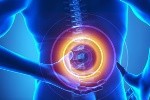Ovulatory Factor
Ovulatory factor accounts for 30% to 40% of all cases of female infertility. Initial diagnoses among women with ovulatory factor infertility may include anovulation (complete absence of ovulation) or oligo-ovulation (infrequent ovulation). Menstrual history may be suggestive if oligomenorrhea, amenorrhea, polymenorrhea, or dysfunctional uterine bleeding is present.
Menstrual dysfunction is present in 18% to 20% of the general population. The normal length of the menstrual cycle in reproductive-age women varies from 21 to 35 days, with a mean of 27 to 29 days. Most of the variability in cycle length occurs during the follicular phase, but the luteal phase, often considered to be fixed at 14 days, can range from 7 to 19 days . Even women with regular monthly menses may have anovulation, although the presence of moliminal symptoms such as premenstrual breast swelling, bloating, and mood changes are much more suggestive of ovulatory cycles.
Methods to Document Ovulation
Basal Body Temperature
This inexpensive method involves daily recording of oral or rectal temperature using a basal body temperature (BBT) thermometer before the patient arises, eats, or drinks. The secretion of progesterone following ovulation causes a temperature increase of about 0.5 to 1[degrees]F over the baseline temperature of 97[degrees]F to 98.8[degrees]F that is typically recorded during the follicular phase of the menstrual cycle.
Ovulation is assumed after 3 consecutive days of raised temperatures. Charting of daily BBTs produces a characteristic biphasic pattern in women with ovulatory cycles. Limitations to BBT include its inability to prospectively predict ovulation and its frequent false-negative results. Smoking and irregular sleep patterns can interfere with accurate BBT testing.
The Fertile Window
The fertile window is the 6 day interval ending on the day of ovulation, but not after ovulation. Sperm can survive for up to 6 days in well-estrogenized cervical mucus, but the egg may be fertilizable for less than a day. Daily intercourse during this window may increase the probability of conception. The average woman is fertile between days 10 and 17 of the menstrual cycle, but many women can conceive outside of this range. Therefore, if timed intercourse is too cumbersome, intercourse two to three times weekly throughout the menstrual cycle will likely result in at least some of those occasions falling within the fertile window.
Luteinizing Hormone Monitoring
At a mean time of 2 hours following the peak of the serum LH surge, urinary LH can be detected. Commercially available kits for documenting the LH surge are generally accurate, quick, convenient,
and relatively inexpensive enzyme-linked immunosorbent assays (ELISA) that use 35 to 50 mIU/mL as their threshold for detection. Once the LH surge is detected, ovulation may occur within the next 48
hours.
The positive-predictive and negative-predictive values for these kits have been described to be 92% and 95%, respectively. Because the duration of the surge may be less than 12 hours, twice daily
testing may increase detection rates. However, the 2 days of highest probability of conception are the day of and the day prior to the LH surge, so this may actually lead to abstaining from
intercourse during a potentially fertile time . False-positive rates occur in 7% of cycles, which may reflect urinary clearance of unsustained premature LH surges. The tests cannot be used in
patients with irregular cycles.
Midluteal Serum Progesterone
When used to document ovulation, serum progesterone measurement should coincide with peak progesterone secretion in the midluteal phase (typically on days 21 to 23 of an ideal 28-day cycle or 7 days following the LH surge). The lower limit of progesterone levels in the luteal phase varies among laboratories, but a level above 3 ng/mL (10 nmol/L) typically confirms ovulation. However, interpretation of isolated luteal-phase measurements of serum progesterone is complicated by the frequent pulses that characterize the secretion of this hormone.
Although ovulatory levels are often considerablyhigher than 3 ng/mL, low midluteal serum levels of progesterone are not necessarily diagnostic of anovulation.
Ultrasound Monitoring
Ovulation is characterized both by a decrease in the size of a monitored ovarian follicle and by the appearance of fluid in the cul-de-sac using transvaginal ultrasound. Follicles reach a preovulatory diameter of 17 to 19 mm in spontaneous cycles or 19 to 25 mm for clomiphene-induced cycles. A combination of LH testing and ultrasound can be used, with LH kit testing starting when the ultrasound-measured follicle size reaches 14 mm.
Ten percent of the cycles of normally fertile women may have a luteinized unruptured follicle, whereby progesterone is released and the luteal phase progresses normally without visible signs of
follicle rupture when daily ultrasounds are performed from cycle days 10 to 20. This incidence is increased to 25% in women with unexplained infertility. Because of the inconvenience and expense of
serial measurements, ultrasound monitoring should be reserved for patients who fail less expensive methods for detecting ovulation or for certain types of ovulation induction.
Contact Us
Chalmers Medical Building
328 Hwy 7 East Suite 201,
Richmond Hill ON L4B 3P7
Tel: 416 399-3888
E-mail: info@aahclinic.com
Conditions Treated
Effective Herbal Therapy for Inflammatory Bowel Disease
NO Surgery!
Carolyn XU Treats Ulcer Colitis Successfully
Considering Therapy?
Resource Links
References
Donation
Great things happen when you put your heart into it.
Click Here to Send us your request
Tips
Questions about your first appointment or if your insurance will cover the cost? Find more information below.















